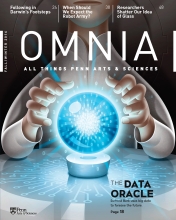A mathematician and physicist who translated Isaac Newton’s Principia Mathematica into French. A British thinker who was admired by the canonical philosopher Gottfried Leibniz. A theoretician who argued that men and women should be considered equal under God.
These historic figures number among a little-known group of female philosophers who wrote and disseminated their ideas in Europe during the 17th and 18th centuries. Some of these women were famous in their own time. Others worked in the shadows. But all were nearly lost to history. Now, the work—and lives—of these formidable women are being rediscovered by a new generation of philosophers, including Karen Detlefsen, associate professor of philosophy and education.
“Some of these women were well known and respected in their own times, and some worked behind the scenes but were still influential,” says Detlefsen, who specializes in early modern philosophy and is co-editor of the book Women and Liberty, 1600 to 1800: Philosophical Essays, a collection of academic studies forthcoming from Oxford University Press.
Her rediscovery of female philosophers of this era began when she was researching her thesis. Poring through letters from Leibniz to a fellow philosopher, she came across a sentence that would change the course of her academic life: “My system most closely resembles that of Anne Conway,” he wrote.
“I was stunned to see the name of a woman in his letter,” says Detlefsen. “Conway was an English aristocrat, and, it turns out, an influence on Leibniz. Reading that name bowled me over.”
Detlefsen wondered if Conway—who lived and wrote in the mid-17th century—was a one-off example of a woman philosopher of that era.
“I wanted to see if there were more, so I started searching for them,” Detlefsen says. “I learned that there were dozens and dozens of female philosophers who lived during the 17th and 18th centuries in Europe.”
These women were writing during a time that was “very much the age of the independent thinker,” Detlefsen explains.
It was an era when the traditional seats of philosophy, monasteries, and universities—which excluded women and anyone not in the upper classes—were giving way to those not in the educational elite.
“During this time the autodidact gained a lot of currency because the thinking was that the human mind is an independently powerful thing, and you don’t need an authority to figure out great things,” Detlefsen says.
Important female thinkers of this era were almost always women from elite social classes, and many of them held aristocratic titles, such as Lady Anne Conway, who was a viscountess, and the Duchess of Newcastle-upon-Tyne Margaret Cavendish. Other famous names from this era include English feminist and philosopher Mary Astell, and the Frenchwoman Émilie Du Châtelet.
A friend and collaborator of Voltaire, Du Châtelet was renowned in her day for her brilliance in math and physics, and it was she who first translated Newton’s writing into French. Her work fell into disfavor with the advent of the French Revolution, which brought down the monarchy and aristocracy. During the revolution, Du Châtelet’s son was executed and her work became relegated to obscurity.
“I wouldn’t call these women philosophers ‘feminists’ because that term and a well-worked out understanding of feminism didn’t show up until the 19th century,” Detlefsen says, “but they were astute in capturing the psychological lives of women and were addressing the idea that men and women are fundamentally equals.”




